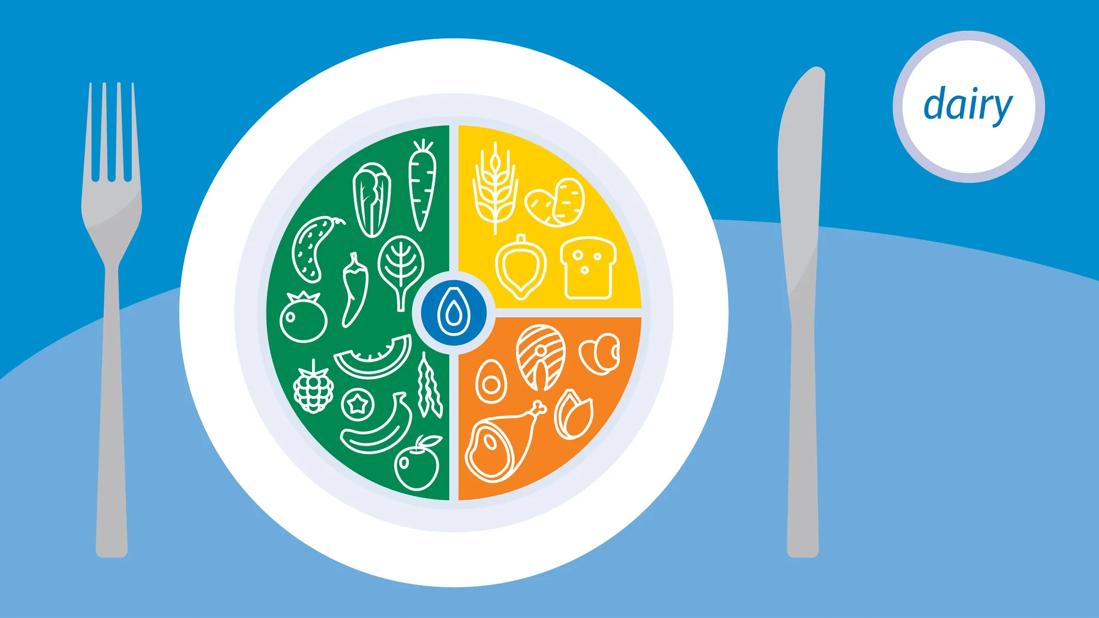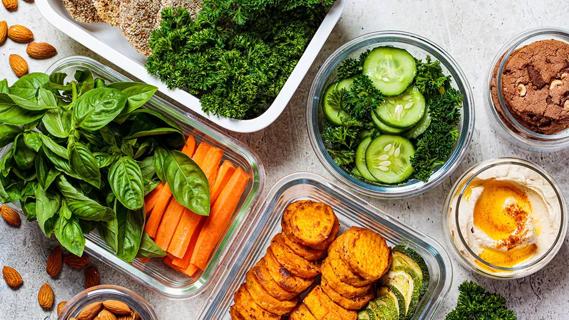A typical recommended balanced diet is half fruits and veggies, a quarter protein and a quarter grains

We’ve all heard that it’s important to eat a well-balanced diet. That eating the right mix of foods can help you be healthier, live longer and keep up your energy.
Advertisement
Cleveland Clinic is a non-profit academic medical center. Advertising on our site helps support our mission. We do not endorse non-Cleveland Clinic products or services. Policy
But if you’re not sure what exactly constitutes a “balanced diet,” or aren’t sure whether you’re following one, you’re not alone.
A 2022 study shows that about 85% of people surveyed believed their diets to be healthier than they actually were.
It’s tough to eat a healthy or balanced diet if you don’t have a clear understanding of what that means exactly.
We talked with registered dietitian Paige Welsh, RD, LD, to set the record straight.
If you could sum up a healthy balanced diet in one word, Welsh suggests that word would be “variety.”
“At its core, a balanced diet isn’t about picking and choosing ‘best’ foods or focusing on ‘superfoods.’ It’s about eating a range of nutritious, whole foods,” she clarifies.
“A balanced diet is about getting a good mix of foods, colors and macronutrients. Because that’s what will help you get all the vitamins and nutrients your body needs.”
In other words, it’s not about “balancing” out your double cheeseburger and fries with a mountain of blueberries. It’s about following an eating plan that covers all the food groups in healthy proportions.
If you’re of a certain age, you may have learned about a balanced diet based on the food pyramid. That old-school model emphasized grains as the basis of healthy eating, followed by fruits and vegetables and then dairy and protein.
Advertisement
Things have changed.
The U.S. Department of Agriculture (USDA) retired the food pyramid in 2011. These days, MyPlate is the standard for balanced eating for the general public. That is, people who don’t have nutritional needs that require more specialized nutrition planning. So, if you’re living with a health concern that requires a more purposeful eating plan — like Celiac disease, gastroparesis or kidney disease — you’re best off following a diet specific to your condition.
At their most basic, the standards set by MyPlate encourage:
Those are the most general estimates. But there’s also a MyPlate Plan tool that can suggest adjustments for you based on factors like your height, weight and activity level.
“Someone who is six-foot-three and plays basketball five days a week will have different needs than someone who’s 5'2" and has a less active lifestyle,” Welsh notes. “A healthy, balanced diet can look different for different people.”
What we all have in common, though, is that eating a balanced diet comes back to getting more of the nutritious foods your body needs and less of the stuff it doesn’t.
Let’s look at the general recommendations for each food group.
It shouldn’t come as a surprise that fruits and veggies are an important component of balanced eating.
But ... that they should take up half your plate? That can catch some people off guard.
“A traditional American diet typically looks like a really large portion of protein, a roughly equal portion of starch and a smaller portion of vegetables,” Welsh reports. “So, considering your produce intake to be half your diet can feel like a big change for some people.”
Less important than the specific fruits and vegetables you eat on a given day is mixing it up. Remember — variety is key.
“The colors in your fruits and vegetables can tell you a lot about the nutrients inside,” she continues. “So, if you’re having green leafy vegetables, as well as some reds, oranges, etc., you can feel confident you’re getting a range of vitamins.”
One thing to watch out for when choosing your vegetables: starch.
Foods like peas, corn and potatoes are high in starch. And you want to keep the fruit and veggie half of your plate on the non-starchy side.
“Starchy vegetables are better included with that quarter of our plate that’s grains. Because the nutrients those veggies provide us are more closely related to those we find in grain,” Welsh explains. “Starchy vegetables are great for fiber, which is important and a good thing to include in a balanced diet. You don’t have to avoid starches. Just consider them part of the grains category.”
Advertisement
Protein is an important part of a balanced diet for a number of reasons. Protein helps you:
Often, people think of protein as coming from meat and other animal products, but there are plenty of healthy vegetarian and vegan proteins, too.
And some animal proteins can have some downsides.
“A limited amount of red meat, like beef, can be part of a healthy diet. But red meat is typically high in saturated fats,” she shares. “You want the majority of your protein to come from lean sources. That is, proteins that contain unsaturated fats or low amounts of saturated fats.”
How much protein you need will vary based on factors like your activity level, muscle mass and more. But aiming for a quarter of your diet to be protein is a good start.
Consider these healthy sources of lean protein:
Grains and gain-containing foods are essentially carbohydrates. And carbs can get a bad rap. After all, there are a host of fad diets and eating plans out there that will have you believing that carbs are public enemy No. 1.
Advertisement
For some people, a low-carb or carb-free diet is appropriate. But if you’re looking for a balanced diet, carbs and grains are part of the game.
“It’s a matter of being choosy about your grains,” Welsh shares. “Some grains and carbs can come with some important health benefits.”
The right grains can help with things like:
But what are the “right” grains?
MyPlate recommends grains to account for 25% of your daily food intake. And half of that should be whole grains — as opposed to refined grains.
What’s the difference? In a word: fiber.
“Generally speaking, your whole grains are going to have more fiber in them,” Welsh states.
Examples of whole grains include:
Why whole-wheat over white?
When wheat is growing in a field, it contains a lot of fiber. Simply speaking, when wheat is milled, it can go one of two directions:
“White bread is a refined grain, which basically means they've taken more of the nutrients out of it. The word ‘whole’ is an indication that the fiber and all the different parts of the wheat are intact, which is what we want,” Welsh explains.
Advertisement
Perhaps the most notable reason that dairy is included as part of a balanced diet is that the calcium in dairy is critical to helping keep your bones strong. What’s more, many dairy products are fortified with vitamin D, which isn’t found naturally in most foods.
MyPlate recommends adults consume 3 cups of dairy daily. What counts as a cup of dairy?
Not everyone consumes milk-containing products, of course. If you’re lactose intolerant, follow a vegan diet or otherwise avoid animal milks, you can still get calcium from other products. That includes foods like calcium-fortified orange juice, canned sardines and tofu made with calcium sulfate.
MyPlate advice may not recommend a sweet treat as a part of your balanced diet. But that doesn’t mean there’s no place for an occasional indulgence.
“I always like to tell my patients, ‘Dietitians eat cake, too,’” Welsh reassures. “But keeping the portion small and saving it as an every-now-and-again thing is the key.”
After all, a balanced diet is about ... well, balance. And part of that includes the once-in-a-while candy or cookie.
“The goal isn’t to deprive yourself. And a diet that’s too restrictive is hard to keep up long-term,” she states.
So, be kind to yourself. Allow some wiggle room. But know that following a balanced diet that features a variety of fruits, vegetables, whole grains, protein and dairy will serve your body best.
Learn more about our editorial process.
Advertisement

With a focus on internal cues for hunger and fullness, this eating style may revolutionize your relationship with food

Review the ingredients, watch for sugar and fat, and choose one with the right amount of protein for your needs

Foods high in protein, fiber and water can help keep hunger at bay

This quirky food trend is harmless, as long as you’re getting enough protein, fiber and healthy fats

This vital nutrient helps your brain and body in many ways — and most of us need more of it

Wrapped or sandwiched, try to choose fillings and condiments that are minimally processed, low in saturated fat and high in fiber

Set yourself up for success by carefully choosing your recipes, storage containers and prepping day

These breaks may have some benefits — but they promote an unhealthy attitude toward food

Babies can get congested easily, but you can calm their cough by keeping them hydrated, using nasal drops and running a humidifier

Weight loss may cause loose, sagging skin and muscle loss to your rear

Several conditions, like vitiligo and fungal infection, can cause a loss of pigmentation, leading to white spots or patches on your skin